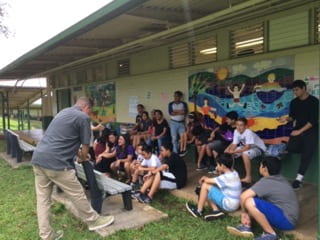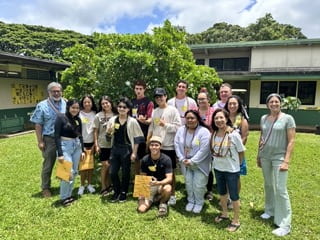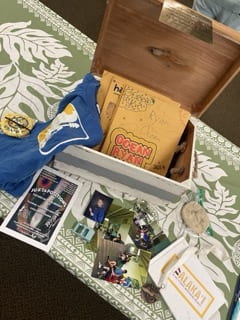Agreement in mind; unanimity of sentiment; union of feeling; oneness; similarity.
Andrews, Hawaiian Dictionary, 1865
ALOHA FOCUS FOR THE WEEK: LŌKAHI
As a six years old, every adult seemed old. I even equated height with age, thinking the tallest humans were the most elderly. Along those lines of thinking, I thought Mrs. Tanaka, my first grade teacher was one of the oldest, wisest person I knew. She probably was in her late twenties, but kid reasoning made me see her as a sage. Towering over us with an ever present smile stretching across her face, I looked forward to her class everyday. Mrs. Tanaka taught me to read and celebrated all of my successes. This enthusiasm was not reserved just for me. She lauded every student in our class, but somehow she made it feel special and personal. Even in 4th grade, when I won a special honor, Mrs. Tanaka was the first person I told. Then in 5th grade, when I got into private school, Mrs. Tanaka gave me a big hug and told me how proud she was of me.
Years later, I wonder if I ever thanked her and let her know how much she meant to me. Back then, we didn’t have Teacher Appreciation Week or even a day set aside to acknowledge teachers – that wasn’t until 1984, and I was well into high school. As a child, it did not occur to me to say, “Thank you for all you’ve done for me. Thank you for giving me the gift of reading and a love for learning. Your validation meant the world to me because I wanted to make you proud.”
We all had a “Mrs. Tanaka.” That is a lōkahi we share. We all had a teacher who taught us a valuable skill, opened our eyes to a new wonder, made us feel safe, and praised us for each step forward we took. Sometimes, our “Mrs. Tanaka” might not be a classroom teacher. It might be an Educational Assistant or tutor that cheered us from the side. It might be a coach or a club advisor that spent long hours guiding our efforts. We may have had a “Mrs. Tanaka” that was a caring adult on campus that did not play a role in the classroom, but watched out for us, picked us up when we fell, and let us know we were seen.
Forty-seven years later I can only hope that wherever Mrs. Tanaka is, she knows that she made a huge difference in the lives of her students – especially during this week as we show our appreciation to teachers, including those informal teachers who work in our cafeteria, office, and taking care of our grounds. Please join me in taking some time to say thank you and let our staff know that what they do is valued and appreciated.
To show LŌKAHI,
- Acknowledge that we share common values; and
- Act in unison in alignment of those values.
5 PURSUITS of LŌKAHI:
Inspired by Gholdy Muhammad
Note: In honor of Asian American and Pacific Islander Heritage Month, I will be featuring books by and/or focused on Asians and Pacific Islanders.
Please watch this: The Beckoning Cat written, illustrated by Koko Nishizuka and illustrated by Rosanne Litzinger.Then with you child, answer the following:
IDENTITY: The maneki neko is a symbol of good luck in Japan that has been adopted by many Asian American restaurants and stores. Learn about and share the animals that symbolize good luck in your family or culture.
SKILLS: More than good luck, gratitude seems to be a theme in this book. How do the characters in this book show gratitude? Provide examples from the book.
INTELLECT: “The beckoning cat may seem to us to be waving, rather than beckoning. In the United States, we hold our hands upright with the palm facing us and beckon with one or all of our fingers. In Japan, and throughout Asia, this gesture is used to beckon dogs, not people, and is considered rude when directed toward people. To call a person over to you, you would put your fingers downwards, as the cats in the picture do, and beckon with all the fingers. While studying the story of Maneki Neko, make an effort to use this gesture instead of the usual American one. Consider studying about other cross-cultural differences in gestures.” (Source: Fresh Plans)
CRITICALITY: The maneki neko has been adopted by people across the world as a good luck charm. How might borrowing from and learning about other cultures promote connection and greater harmony?
JOY: Try making an origami maneki neko out of a square piece of paper. Here’s a more advanced version and a simpler one.
A MOMENTOUS OCCASSION
Six years ago, I joined a core group of leaders in using the Design Thinking process to develop and pilot a mentoring program for our 6th graders. Sixth grade is a critical year in a child’s development. As they enter puberty, beyond the obvious physical changes, children experience intense emotional changes.. They become mercurial causing them to feel confused, scared, angry and not know why. Peer acceptance grows in importance while parental approval diminishes in priority. So we thought, maybe pairing our sixth graders with a positive role model from Castle High School might help them with this transition and make better choices. The mentors had lunch with sixth graders once-a-week for a couple of months. The leaders planned out activities so the pairs could bond and arranged the transportation. Back then, the seniors had a very tight schedule and needed to promptly return for class. In the end, although the program was a great success, it was not sustainable due to transportation issues and the rigid high school schedule. So the pilot lasted a year with only a time capsule the mentoring pairs contributed to at the end of the program, May 5, 2017. Six years to the date, we gathered a few of the former 6th graders who are now seniors at Castle and their mentors who are in their professional careers. We reminisced, reconnected and ended the day opening the time capsule. None of the participants could recall what they wrote, but valued the words their younger selves put down on paper. Now that Castle’s schedule has changed and there is greater flexibility, there might be a chance we can revive this wonderful, important opportunity. In the meantime, mahalo nui loa to those who gathered including the mentors (Hannah Deitch-Cumming, Jesy Iwamasa, Keilee Simms, and Kai Zimmerman), mentees (Kaimana Arruda, Devon Hirao, Tyler Masumoto, Miala Matsumoto, Marley Pokipala, Roman Skonecki, and Emmalyn Uyehara) and especially the program coordinators (Nathan French, Ayada Bonilla, Shareen Masumoto, and Karen Kimura) who made this wonderful day possible.
SBA TESTING
We continue our Smarter Balanced Assessment (SBA) testing this week and through May 19, 2023. Please ensure your child
- has a good nightʻs rest;
- eats a healthy breakfast;
- bring their headphones to school; and
- is on time for school.
Tardy students cannot take the SBA on the day they are tardy.
During this time period, we will also cancel our daily piko on testing days. We will resume piko on Monday, May 15.
UPCOMING EVENTS
| Sat, May 13, 2023 | Campus Beautification #2 |
| Apr 25 – May 19, 2023 | Smarter Balance Testing at Kāneʻohe ElementaryNo piko |
| Mon, May 15, 2023 | Daily Piko returns |
| Thur, May 25, 2023 | 6th Grade Promotion Ceremony |
| Fri, May 26, 2023 | Awards CeremonyLast day of school |


